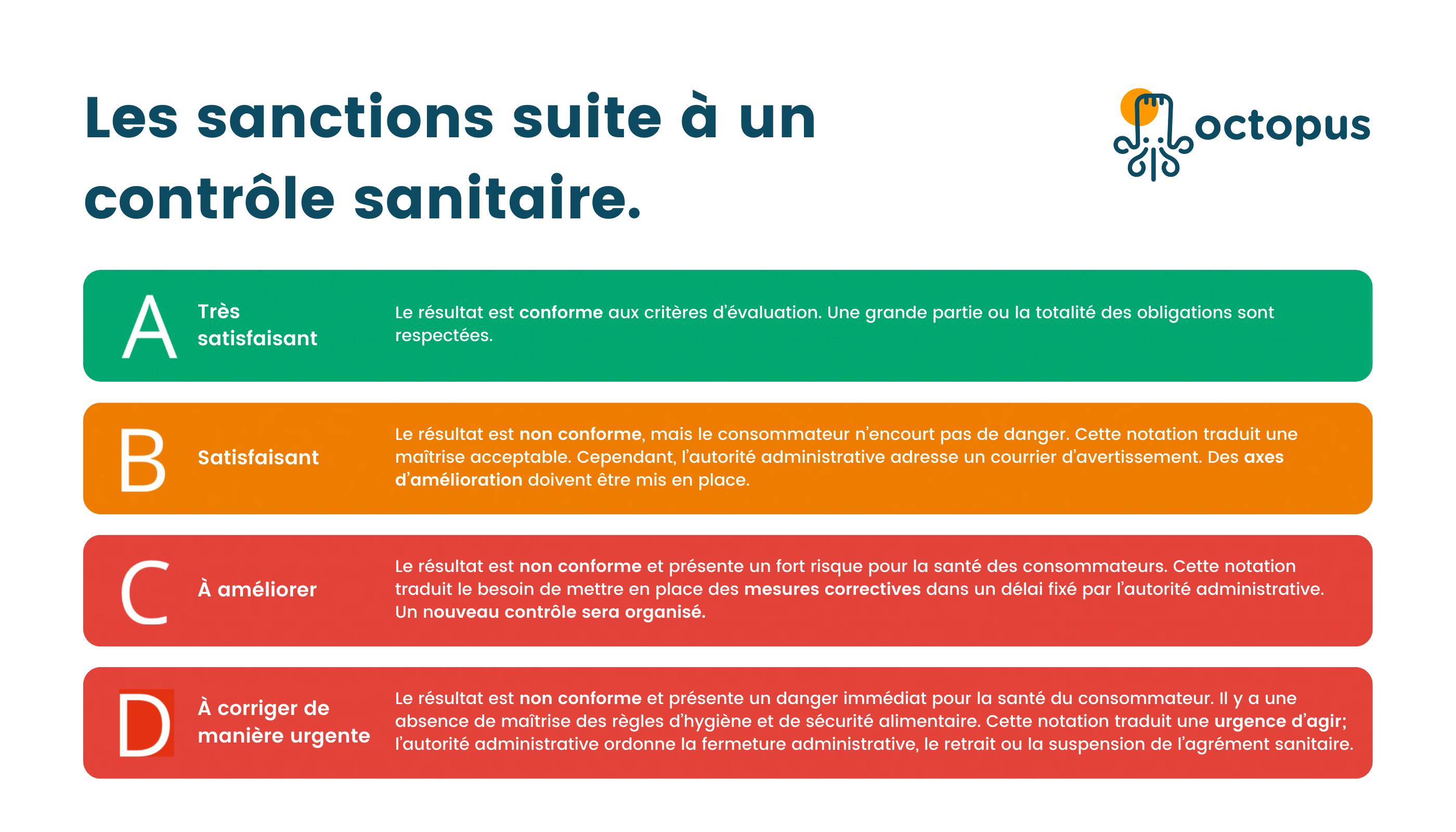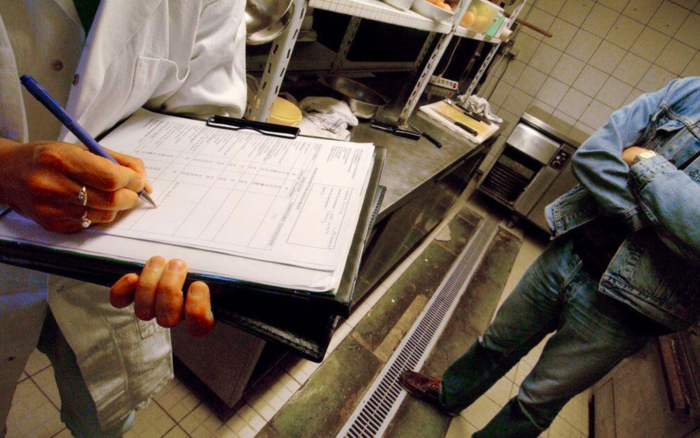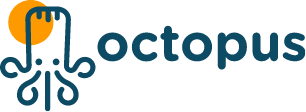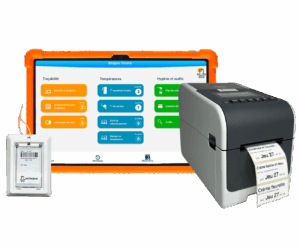Pass your restaurant hygiene inspection!
Comprendre l’HACCP
⏳ Temps de lecture : 8 min
? Mis à jour le : 01/08/2024
Summary
- Health checks in a restaurant: a complete guide
- The aims of health checks in a restaurant
- When can a health check in a restaurant take place?
- How to prepare for a health check in your restaurant?
- The procedure during a restaurant health inspection
- Documents to prepare for a restaurant health inspection
- Which organizations carry out restaurant health inspections?
- How are restaurant health checks assessed?
- What are the risks and penalties following a health check?
- The Octopus HACCP application, for worry-free checks
- Can consumers initiate a health check?
- Difference between control operation and surveillance
- Key figures around sanitary controls in restaurants
- Sanitary control in restaurants: conclusion
- Consult sanitary control results on Alim confiance
Food hygiene inspection in restaurants: Complete guide?
What happens during a restaurant health inspection?
Food hygiene inspections in restaurants can be intimidating. Having inspectors from the Departmental Directorate for Population Protection arrive during peak service can be stressful. Since these food hygiene inspections are random ? and can occur at any time, proper preparation might seem challenging. However, a restaurant hygiene inspection doesn’t always result in severe penalties.
A restaurant food hygiene inspection can become a mere formality provided you follow HACCP method fundamentals. ✅
So don’t panic! In this article, we’ll help you properly prepare for these health inspections in your restaurant so you can pass them with flying colors. ?
A good understanding of HACCP method basics and common sense are the only prerequisites for this article.
The objectives of restaurant health inspections?
These food hygiene inspections aim to:
- Verify compliance with GHP (Good Hygiene Practices) to ensure protection of health and environment ? ;
- Ensure proper implementation of the HACCP method ✅ ;
- Check food traceability for consumer protection ?. This helps identify potential risks from hygiene failures and protects consumers from unsafe products.
When can a restaurant health inspection occur?
Health inspection visits to restaurants ? can occur on various occasions. An initial health inspection of your restaurant is conducted after opening to verify compliance with all requirements. This first food hygiene inspection is scheduled ⏰ before the restaurant opens, following submission of your mandatory health declaration to the DDPP, which since January 1, 2024 has been called the SSA police. ?✈️
This initial visit is announced to the establishment manager. Subsequent health inspections are either scheduled at regular intervals or conducted unannounced.
How to prepare for your restaurant’s health inspection? ?️
To begin with, the SSA police may conduct initial anonymous checks, ? such as inspecting dining area cleanliness, staff hygiene, etc.
The best way to be prepared for a restaurant health inspection is to routinely comply with HACCP method requirements, not just in anticipation of an inspection. ?
Free training: We’ll prepare you to be inspection-ready and compliant. ?
In 2024, health inspections in restaurants and all food service businesses will intensify.? This is due to the special context of the Paris 2024 Olympic Games and the expansion of hygiene inspection teams. 150 new inspectors ?️♀️ have been hired by the government to conduct 80% more inspections in 2024. Prepare to be inspected more frequently than before! ⏳
We invite you to free training sessions, ? where we’ll provide all practical information to understand regulatory changes, key HACCP inspection points, and useful tools ? to implement for compliance.
We’ll also be happy to answer all your questions during the training. Register quickly as seats are limited. ?
Restaurant hygiene inspection procedure?
The food safety police (formerly DDPP) ? may access all areas of your establishment and examine all facilities, work equipment, and food present. ?
The health inspector will review hygiene procedures and regulations ✅ implemented in your establishment. Here’s a non-exhaustive list (knowing this may vary by inspector):
- Information regarding the food supply chain ? ;
- Design and maintenance of premises and equipment ? ;
- Pre-operational, operational and post-operational hygiene;
- Staff hygiene practices;
- Hygiene and work procedure training;
- Pest control ? ;
- Water quality ? ;
- Temperature monitoring ? ;
- Inspection of food products entering/leaving the establishment and accompanying documentation.
Documents to prepare for a restaurant hygiene inspection?
During your restaurant’s health inspection, the inspector may also request certain documents ? and records:
- Cleaning, disinfection ? and pest control logbook;
- Goods received records ? ;
- Temperature monitoring logs ? ;
- Facility and equipment maintenance records (e.g., hoods, extractors, etc.);
- Staff training documents (particularly HACCP – you may hear about this training under various names) and their competency certificates ? ;
- Periodic microbiological analysis reports ? ;
- Supplier contact details ? ;
- Customer contact information (for business deliveries).
There are no mandated formats for documents required during restaurant health inspections. Regulations primarily require compliance with outcomes. You may provide this information in paper or digital format, such as via the Octopus HACCP application. ?
Which organizations carry out sanitary inspections in restaurants?⚖️
- In establishments handling direct food distribution to customers like retail, food service businesses ?, commercial catering, markets…
- For monitoring product withdrawals and recalls in retail outlets following health alerts;
- For conducting sampling ? as part of surveillance and control programs.
In total, nearly 6,000 inspectors and approximately 14,000 state-certified veterinary inspectors are deployed for food safety oversight.
How are restaurant hygiene inspections evaluated?
The purpose of restaurant hygiene inspections conducted by the SSA police is to assess each establishment’s hygiene standards and compliance with HACCP regulations specific to each food service sector.
Hygiene levels are evaluated according to 4 rating levels:
- Excellent ?: the establishment complies with good hygiene practices or only shows minor non-compliances;
- Satisfactory ?: this rating is given if the food safety police issued no sanctions but had to send a regulatory reminder letter to improve practices;
- Needs improvement ?: this rating applies if authorities had to formally order the establishment to comply with health regulations within a given timeframe under threat of sanctions. A follow-up inspection is scheduled to verify corrective measures;

What are the potential risks and sanctions following a health inspection?
There are 3 different types of sanctions that may be imposed on establishments failing to comply with health regulations:
- Administrative sanctions ?
During a restaurant health inspection, if the SSA police identifies hygiene violations, they send a letter ? to the establishment’s responsible party. This letter details the findings from the inspection and corrective measures required to achieve compliance with safety and hygiene standards. ?
These corrective actions must be implemented within a specified timeframe. At this stage, it’s only a warning. ⚠️
- Legal penalties ⚖️
Following the restaurant inspection, based on documented violations ? by food safety authorities, the DGCCRF (Directorate General for Competition, Consumer Affairs and Fraud Control) files a report with the prosecutor. This may result in a fine, substantial penalty ?, or even imprisonment ⛓ for serious offenses.
- Administrative closure ?
This represents the most severe sanction. If the establishment is deemed non-compliant with current regulations and poses a public health risk, the prefect may order its closure ?. This may be accompanied by heavy fines and/or jail time. ⛓
These sanctions can be avoided by implementing corrective actions and demonstrating good faith efforts to comply. For example, completing HACCP training can help establish a proper monitoring framework and implement effective daily self-inspection procedures. Restaurant health inspections will then no longer be a source of stress!

The Octopus HACCP app for stress-free inspections?
For two years, Octopus HACCP has been supporting the Delicrepe team to ensure safety and hygiene compliance. Nicolas Cantau, founder of Delicrepe, shares his experience ? of a successful hygiene inspection with Octopus HACCP:
“We had a hygiene inspection and with the Octopus HACCP app everything went perfectly!“
All documents required by food safety authorities are available in the app ? and can be accessed at a glance.
The perfect way to breeze through restaurant health inspections quickly and with complete confidence!
Can customers request a health inspection?
Yes, consumers who observe ? clear hygiene violations in a restaurant can report these issues to fraud prevention authorities. The establishment in question will be notified of the problem ⚠️ and given an opportunity to achieve compliance before any potential follow-up restaurant health inspection.
Difference between inspection and monitoring operations ?♂️
The difference between inspection and monitoring operations lies in the fact that restaurant health inspections ? are conducted by food safety authorities. They result in an evaluation of the establishment’s hygiene practices ? and potential sanctions for violations that endanger consumer health. Monitoring is an internal operation performed by one or more HACCP coordinators. As an integral part of the HACCP method, it specifically involves verifying that critical control points unique to your restaurant remain within safe limits. This monitoring helps identify health risks ⚠️ and triggers corrective actions when non-compliance occurs. ✅
Key figures on restaurant health inspections?
In 2023, nearly 11,825 restaurants underwent health inspections.
- The majority of them (7,594) received a “Satisfactory” hygiene rating ✅;
- Just over one-third (3,259) achieved a “Very Satisfactory” rating, while fewer than 10% (875) received “Needs Improvement”;
- Less than 1% (97) were classified as “Requires Urgent Correction”.
Sanitary Inspection in Restaurants: Conclusion?
The food hygiene inspection in a restaurant is a mandatory step that certifies good hygiene practices in your restaurant and alerts you in case of non-compliance. Implementing the HACCP method and following the monitoring procedures of your CCPs not only ensures consumer health safety but also helps you anticipate these hygiene inspections so they become simple administrative procedures. ?
By equipping yourself with the Octopus HACCP online application ?, available on mobile, tablet, and computer ?, you simplify the entry of compliance data for your reception, stock entry, and processing operations… Sanitary audit and inspection operations ? in your restaurant are facilitated thanks to comprehensive traceability of your goods and immediate access to your activity history, in compliance with the HACCP approach.
Check Sanitary Inspection Results on Alim’ Confiance?
 Did you know? Since April 3, 2017, consumers can visit the website Alim’ Confiance and directly access the results of food hygiene inspections carried out in establishments, maybe even yours.
Did you know? Since April 3, 2017, consumers can visit the website Alim’ Confiance and directly access the results of food hygiene inspections carried out in establishments, maybe even yours.
It’s your turn to aim for a “very satisfactory” smiley!





